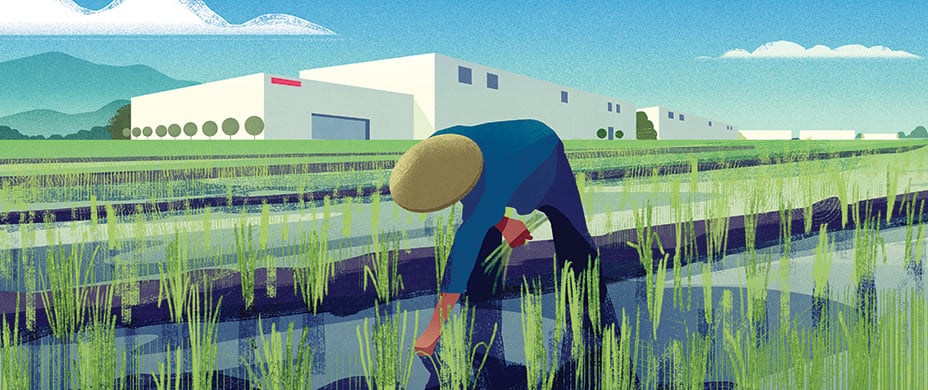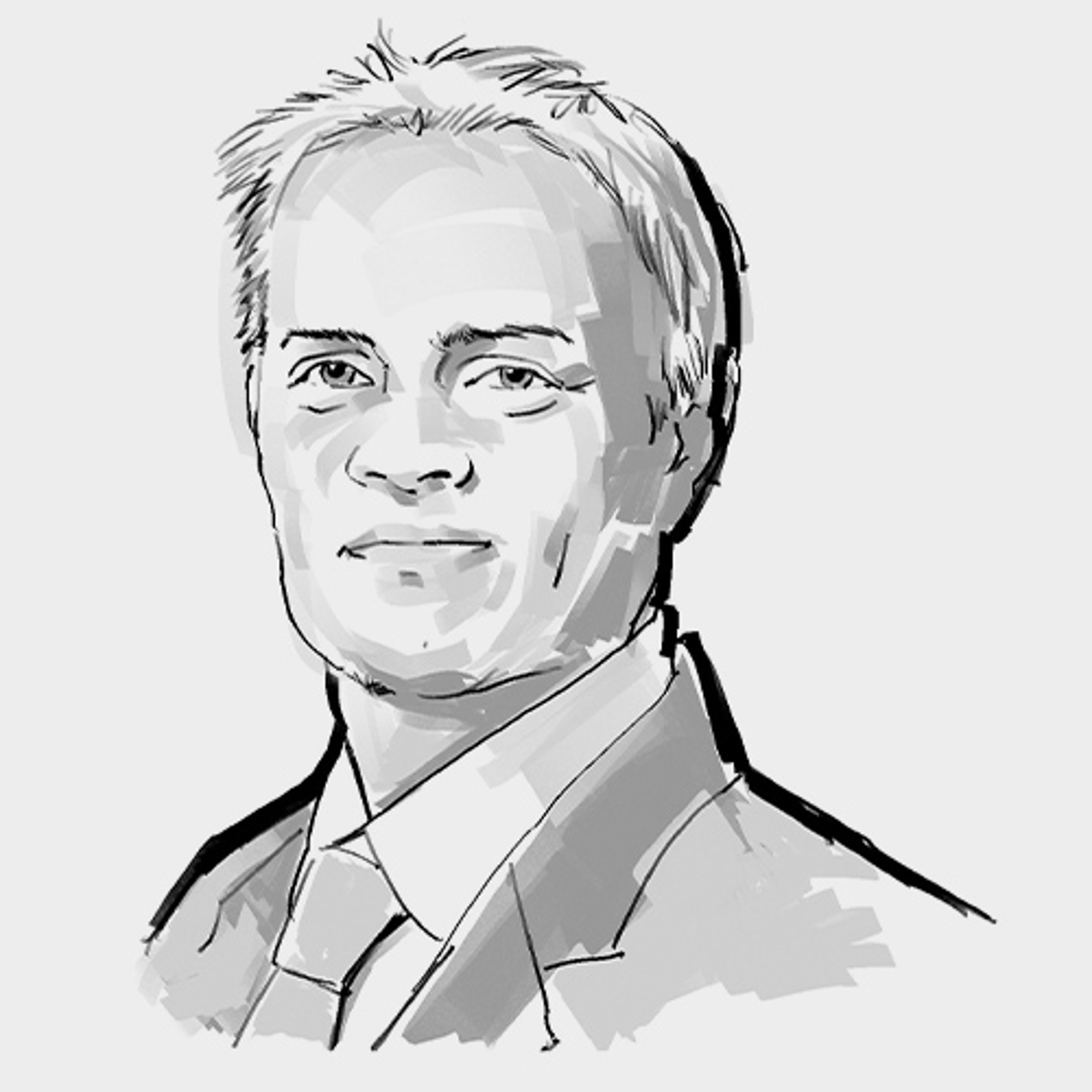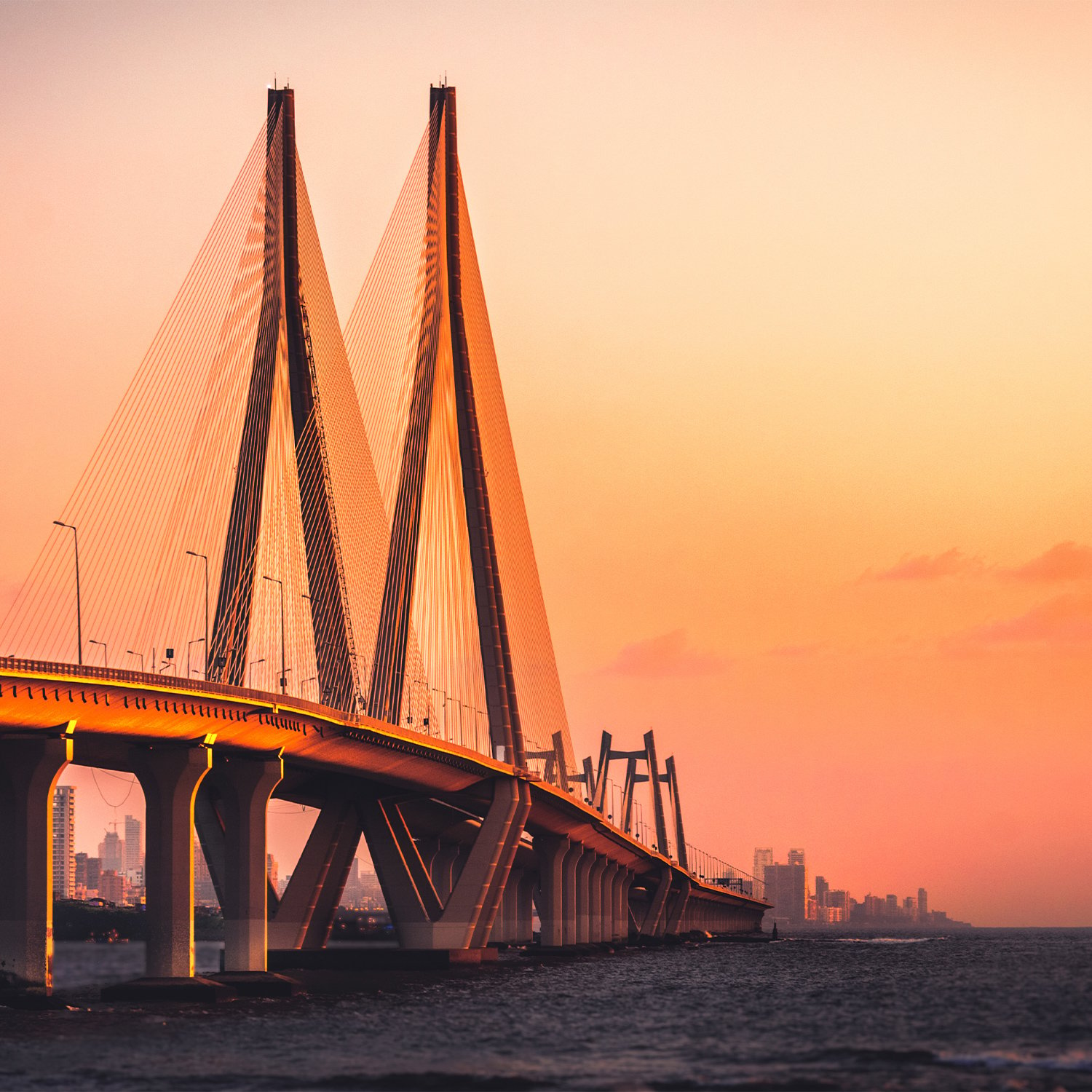
Illustration by Andrew Lyons
Please remember that the value of an investment can fall and you may not get back the amount invested.
In Ho Chi Minh City, rivers of cars and motorcycles endlessly cross and merge from cluttered side streets into French-built boulevards. This intricate interplay, somewhere between cooperation and competition, looks like chaos. But it works.
Sporting a fetching, orange-striped helmet, I’m riding pillion on a 1980s-model Vespa, touring the southern Vietnamese city with the more adventurous board members of Pacific Horizon Investment Trust. Our ride follows a day of back-to-back meetings with Trust portfolio companies and prospective additions. It reacquaints me with the sights, sounds and smells of Saigon: the old name used interchangeably with that honouring ‘Uncle Ho’, communist father of modern Vietnam.
I always enjoy a re-immersion in one of my favourite cities, an evocative fusion of new Asia and old Europe. The buzz and klaxons of uncountable vehicles and the wafting smell of fresh baguettes for Saigon’s meaty, herby bánh mì sandwiches complement passing views of the pompous and picturesque architecture of French colonialism.
The city feels different this time, but why? One tangible change is the increased proportion of four-wheeled to two-wheeled traffic. More widely, I sense a city crossing the threshold from being an emerging market metropolis to something more… emerged. Saigon is still affable and affordable, but its bars and restaurants are smartening up. Things work better than I remember.
Structural growth star
Meetings with company bosses, as well as economists, bankers and Communist Party officials with long titles, reinforce my sense that Vietnam is the best structural growth story of any country in Asia. It’s a likely exception to the rule that most emerging markets never quite get there.
Instead, like Thailand or Malaysia, they get stuck in the ‘middle-income trap’ of about $10,000 (£8,000) per capita. Vietnam is still far short of that at $4,000, but the vibrancy of Saigon and the sense of purpose conveyed in our meetings suggest a country on the fast track trodden by Asian tigers such as South Korea and Taiwan.
I first came here in 2016, which was 10 years after Pacific Horizon first invested via Dragon Capital’s VEIL (Vietnam Enterprise Investments Limited) fund. Dragon was founded in 1995 by a British entrepreneur, five years before the first stock exchange opened in the then-hardline Marxist-Leninist country.
Throughout the 2000s, official ideology and red tape made VEIL the only easy way to invest in Vietnamese firms. But opportunities have opened up since, and after a burst of liberalisation in 2015-2016, we started buying individual companies. Now, about 8 per cent of the Trust’s portfolio is invested in Vietnam, in sectors as diverse as seafood, IT outsourcing services, mobile telephony and construction materials.

March of the makers
Others’ experiences taught Vietnam’s leaders that the only proven way to fund a sustainably growing domestic economy is through manufacturing goods for export. In other words, not by relying on commodities with their cyclical prices or by luring foreign finance, which floods in and out with every regional boom and bust.
How has Vietnam pulled off this trick and become a successful export manufacturing base? After all, it carries heavy geopolitical baggage: many decades fighting France, the US and (briefly) China, plus a bitter civil war and reunification. That anti-capitalist hard line started softening in the late 1980s. Now the government’s priorities include tackling residual corruption, often involving real estate, and sorting out infrastructure failures such as occasional power cuts.
We’re lucky that Pacific Horizon’s board adds valuable perspectives on Vietnam’s progress. On a break in our Vespa tour, over Saigonese street food and beers, I tap into their collective wisdom on the dos-and-don’ts of east Asian development.
One member, Joe Studwell, has written authoritatively on the subject: How Asia Works: Success and Failure in the World’s Most Dynamic Region. The book details the must-haves of reformed and productive agriculture, competitive export manufacturing and tight controls on international capital. Because it has all three, Joe calls Vietnam “the most exciting country [in south-east Asia] from an economic perspective”.
Well positioned
Other favourable factors include 2,000 miles of coastline on the maritime trade highway between east Asia and the west, good relations with China and the US (a rare double), and a young, well-educated workforce.
In Vietnam’s case, being a one-party state – albeit less top-down than China – means a government that gets things done. As in Taiwan and South Korea, both virtual military dictatorships in their rapid development phases, Vietnam’s leaders are focused on doing whatever is necessary for export success.
That includes installing the infrastructure: the ports, the roads and the supply chains that tend to predetermine rapid progress. Vietnam has cannily created a proper manufacturing supply chain, with all the components and logistical structures feeding into making its smartphone or sports-shoe-making factories highly productive and efficient.
Its timing is excellent. China’s Covid-closed ports convinced many offshore manufacturers that relying on one country is risky. Also, as that giant neighbour moves up the value chain in the next couple of decades, a couple of trillion dollars’ worth of low-end manufacturing is likely to leave. We expect a large portion to cross the border to Vietnam.
This partly explains why the big exporters are foreign brands setting up their manufacturing, helped by Vietnamese skills in languages, notably Japanese and Korean. Samsung is by far Vietnam’s biggest exporter, having invested around $12bn in the country in the past six years.
There aren’t yet many Vietnamese exporters of scale for us to invest in. One exception is Vinh Hoan, the world’s largest producer of frozen pangasius, also known as catfish, more appetisingly rebranded as bassa. This white fish is an increasingly popular source of protein, and Vinh Hoan has big global clients, including Tesco, Aldi and Walmart.

Its impressive managers explained their plan to move up the value chain by selling extracts such as collagen, a protein taken as a health supplement. They also discussed exploiting the firm’s freeze-drying expertise to supply other ingredients, such as dragon fruit for smoothies for global coffee chains.
Otherwise, we look for domestic growth stocks buoyed up by a growing wave of prosperity and a rising middle class. One example is Mobile World, which accounts for about 50 per cent of local mobile phone sales and runs a growing grocery chain. We also look for the best of Vietnam’s outsourcing companies, such as FPT, Vietnam’s IT and telecoms leader and a global powerhouse for digital services. Its biggest market is Japan, serving Sony, Hitachi and Panasonic.
Farms to factories
From the capital Hanoi, where we’ve flown for the final phase of our trip, we travel by minibus to Bac Ninh Industrial Zone. Vietnamese hosts like to show off this giant business park between the capital and the northern port of Haiphong.
Its backdrop is not the tourist-brochure Vietnam of sugarloaf mountains and tiered green paddy fields but flat utilitarian farmland. A dull landscape, maybe, but one whose productiveness seeded the country’s present success.
Thanks to communist land distribution and subsequent pro-market reforms, Vietnam’s farming became profitable and more competitive. Its productivity far outstripped that of its south-east Asian neighbours, providing the capital and releasing the labour that helped kickstart the thriving manufacturing sector.
Now this ancient peasant-farmed plain is being encroached by neat roads, roundabouts and well-tended topiary, peppered with vast hangar-like factories whose signage proclaims a who’s-who of multinational manufacturing: Canon, Microsoft, Samsung, Foxconn. Will there be more native Vietnamese names among them next time I come? I got a feeling from my meetings that there will be. Beyond these rows of cavernous sheds and surrounding car parks, the fields stretch to the horizon, offering endless space for growth.
To discover more about Pacific Horizon’s view of Vietnam and its neighbours, listen to the Trust’s deputy manager Ben Durrant in our podcast series at bailliegifford.com/podcasts
Important information
Investments with exposure to overseas securities can be affected by changing stock market conditions and currency exchange rates. Pacific Horizon Investment Trust invests in emerging markets where difficulties in dealing, settlement and custody could arise, resulting in a negative impact on the value of your investment.
The views expressed in this article should not be considered as advice or a recommendation to buy, sell or hold a particular investment. The article contains information and opinion on investments that does not constitute independent investment research, and is therefore not subject to the protections afforded to independent research.
Some of the views expressed are not necessarily those of Baillie Gifford. Investment markets and conditions can change rapidly, therefore the views expressed should not be taken as statements of fact nor should reliance be placed on them when making investment decisions.
Baillie Gifford & Co Limited is wholly owned by Baillie Gifford & Co. Both companies are authorised and regulated by the Financial Conduct Authority and are based at: Calton Square, 1 Greenside Row, Edinburgh EH1 3AN.
The investment trusts managed by Baillie Gifford & Co Limited are listed on the London Stock Exchange and are not authorised or regulated by the Financial Conduct Authority.
A Key Information Document is available by visiting bailliegifford.com
92921 10045445





